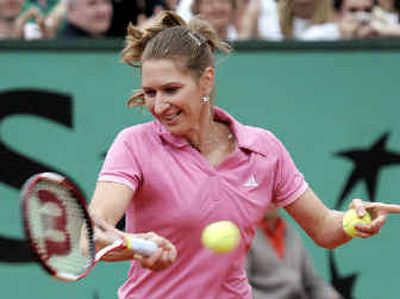French fans grab glimpse of Grand Slam great Graf

PARIS – Steffi Graf brought back a flood of memories for French Open fans on Sunday when she returned, racket in hand, to the scene of her most emotional, and final, Grand Slam triumph.
Though she played only an exhibition mixed doubles match, Graf’s rare court appearance the day before the start of the tournament served as a reminder, too, that the era has long since passed when one player dominated the women’s tour for many years at a time.
The mother of two toddlers and wife of Andre Agassi, Graf is not about to take up tennis in seriousness again. For her, the sport was all or nothing, as it was for Monica Seles when she reigned and Martina Navratilova and Chris Evert did during their years at the top when the women’s game was less deep.
Graf didn’t take up acting, do a lot of fashion shows, design clothes or otherwise divert her attention from the business of whacking the ball over the net. That devotion to the game paid off with 107 WTA Tour singles titles, including 22 in Grand Slams. She won the French six times, the first time for her first major when she was 17 in 1987.
Since Graf’s retirement following her victory over Martina Hingis at Roland Garros in 1999, the women’s tour has seen a succession of players rule. Lindsay Davenport, Jennifer Capriati, Venus and Serena Williams, Kim Clijsters, Justine Henin-Hardenne and Amelie Mauresmo all have had their turns at the top of the rankings.
Serena Williams has been the most dominant during that stretch, winning the French in 2002 en route to capturing four straight major singles titles and six altogether, including this year’s Australian Open. But injuries, the tragedy of her older sister Yetunde’s fatal shooting in 2003 and dalliances in other endeavors have combined to drop her in the rankings. She pulled out of the French on the day of the draw, citing a lingering ankle injury.
Davenport, who considered retirement last year, is No. 1 but hasn’t won a major since the Australian Open in 2000. Capriati had surgery on her right shoulder in January and is still out. Venus Williams, who debuted a custom-designed apparel line in Paris a year ago, hasn’t won a major since Wimbledon in 2003.
As the top-seeded woman despite her aversion to clay, Davenport will be on center court in the opening match Monday against Slovenia’s Katarina Srebotnik. The seeded players who follow will be men’s No. 1 Roger Federer, defending women’s champion Anastasia Myskina and defending men’s champ Gaston Gaudio.
Henin-Hardenne, who won’t play until Tuesday, won the French and U.S. Open two years ago, then the Australian last year, but was plagued for much of the past year by a blood virus. Clijsters lost most of 2004 to a wrist injury, then recently hurt her right knee. Mauresmo has been largely healthy and busy on the court, but has reached only one Grand Slam final – the Australian in 1999.
The merry-go-round in the women’s game has had its positive and negative effects.
On the plus side, a series of young stars have emerged, none more promising than last year’s Wimbledon champion, Maria Sharapova. Rather than a mere few women being considered contenders to take a major title, there are perhaps 10 at Roland Garros capable of winning – led by Henin-Hardenne, Mauresmo and Venus Williams, based on recent form.
On the down side, there has been a loss of consistency among the top women, an absence of continuing rivalries and a herky-jerky feeling to the tour. It sizzles one moment, fizzles the next when players pull out of tournaments.